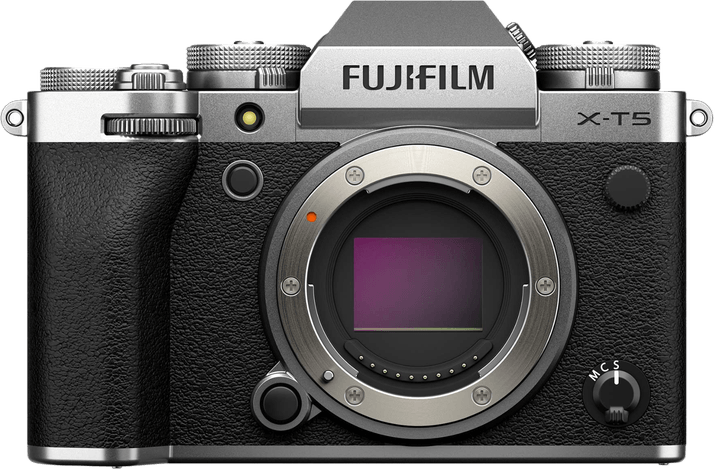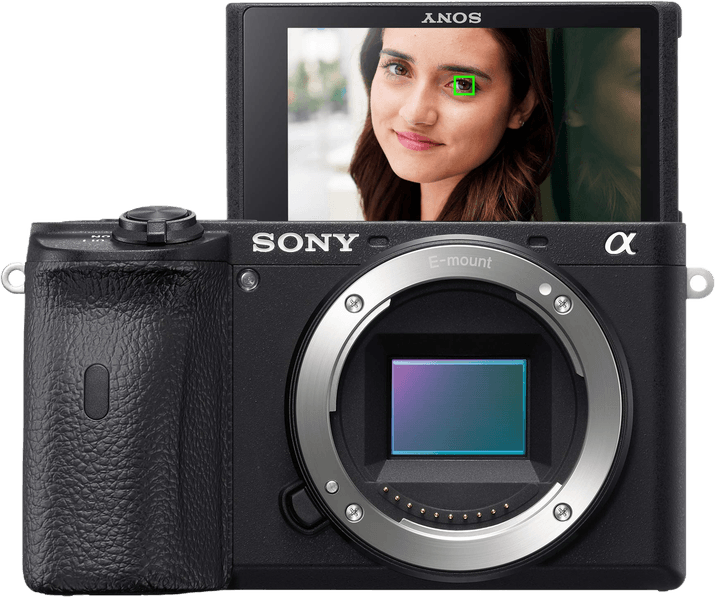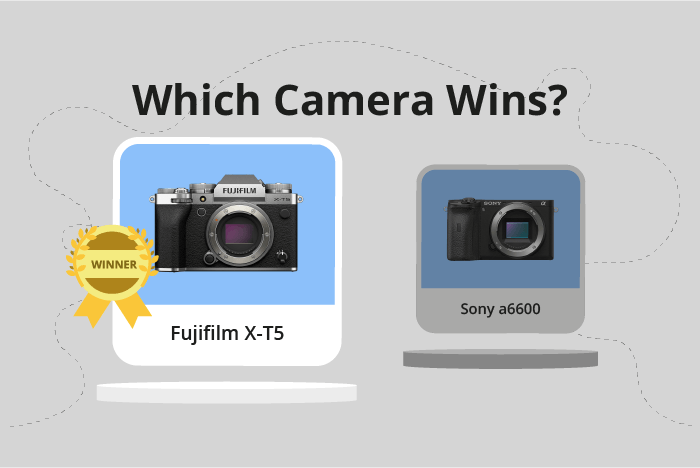Fujifilm X-T5 vs Sony a6600 Comparison
Fujifilm X-T5

Sony a6600

The Fujifilm X-T5 emerges as the winner with a score of 81/100, while the Sony a6600 trails behind at 75/100. Both cameras share similarities as mirrorless cameras, with the X-T5 being released in 2022 and the a6600 in 2019. The X-T5 boasts a higher launch price of $1699 compared to the a6600’s $1200.
The Fujifilm X-T5 outshines the Sony a6600 in terms of size, measuring 130 x 91 x 64mm, making it larger and potentially more comfortable to handle. However, it is also heavier at 557g, which may not suit all users. On the other hand, the Sony a6600 has a more compact design, measuring 120 x 67 x 69mm and weighing 503g, making it lighter and easier to carry around.
While the Fujifilm X-T5 offers better performance with its higher score, the Sony a6600 still has its advantages, such as its lower price and more compact design. Ultimately, the choice depends on individual preferences and priorities when selecting a camera.
Fujifilm X-T5 vs Sony a6600 Overview and Optics
The Fujifilm X-T5 outperforms the Sony a6600 in optics, scoring 81/100 compared to the Sony’s 76/100. Both cameras share several specifications, including a CMOS sensor, APS-C sensor size, and image stabilization. They also have their respective lens mounts: Fujifilm X for the X-T5 and Sony E for the a6600.
The X-T5 excels with its 40-megapixel resolution, significantly higher than the a6600’s 24.2 megapixels, resulting in more detailed images. Additionally, the X-T5 has a faster shooting speed at 15 frames per second (fps) compared to the a6600’s 11 fps, allowing for better continuous shooting and capturing fast-moving subjects. The X-T5 also features the X-Processor 5, which enhances image processing and overall camera performance.
On the other hand, the Sony a6600 boasts a DXOMARK sensor score of 82, while the X-T5 does not have a DXOMARK score due to their policy of not scoring Fujifilm cameras. This score indicates the a6600’s sensor performance, which may provide advantages in certain shooting conditions. The a6600 also uses the Bionz X processor, which supports fast autofocus and reliable image quality.
Taking these factors into account, the Fujifilm X-T5 outshines the Sony a6600 in terms of resolution and shooting speed, making it the better choice for photographers seeking high-quality images and fast performance. However, the Sony a6600 may still appeal to those who prioritize sensor performance as indicated by the DXOMARK score, and it offers a solid alternative with its reputable Bionz X processor.
Fujifilm X-T5 vs Sony a6600 Video Performance
The Sony a6600 emerges as the winner in video capabilities, scoring 91/100 compared to the Fujifilm X-T5’s score of 87/100. Both cameras share some common specifications, such as having time-lapse functionality built in.
The Sony a6600 outshines the Fujifilm X-T5 with its higher maximum video frame rate of 100fps, compared to the X-T5’s 60fps. This feature allows the a6600 to capture smoother slow-motion footage and provides more flexibility in post-production. Despite having a lower maximum video resolution of 4K (3840 x 2160), the a6600’s higher frame rate makes it a more versatile option for videographers.
On the other hand, the Fujifilm X-T5 boasts a higher maximum video resolution of 6K (6240×4160), which results in more detailed and sharper footage. However, its lower frame rate of 60fps limits its slow-motion capabilities compared to the Sony a6600.
In the realm of video capabilities, the Sony a6600 holds an advantage with its superior frame rate, making it a more suitable choice for videographers seeking smooth slow-motion footage. The Fujifilm X-T5, with its higher video resolution, is a strong contender for those prioritizing image detail and sharpness. Ultimately, the choice between these two cameras depends on the specific needs and preferences of the user.
Fujifilm X-T5 vs Sony a6600 Features and Benefits
The Fujifilm X-T5 triumphs over the Sony a6600 with a feature score of 85/100, while the Sony a6600 scores 81/100. Both cameras share several features, including a 3-inch screen size, touchscreen functionality, flip screen, absence of GPS, and the presence of WIFI and Bluetooth connectivity.
The Fujifilm X-T5 outperforms the Sony a6600 with its higher screen resolution of 1,840,000 dots, compared to the Sony a6600’s 921,600 dots. This higher resolution allows the X-T5 users to enjoy a clearer and more detailed display while framing their shots and reviewing captured images.
Despite its lower feature score, the Sony a6600 has its advantages. Both cameras possess similar features, making the a6600 a worthy competitor to the X-T5. The lower score does not necessarily imply that the Sony a6600 is a bad camera; it simply highlights the Fujifilm X-T5’s superiority in certain aspects, such as screen resolution.
In terms of features, the Fujifilm X-T5 takes the lead with its higher screen resolution, providing users with a better visual experience. The Sony a6600, on the other hand, remains a strong contender due to its comparable features. When considering these cameras, potential buyers should weigh the importance of screen resolution and other factors to determine which camera best suits their needs and preferences.
Fujifilm X-T5 vs Sony a6600 Storage and Battery
The Fujifilm X-T5 outperforms the Sony a6600 in storage and battery with a score of 76/100, compared to the Sony’s score of 48/100. Both cameras share some specifications, such as accepting SD/SDHC/SDXC memory cards and offering USB charging capabilities.
The X-T5 excels with its two memory card slots, providing more storage options and flexibility for photographers. Additionally, it uses the NP-W235 battery type, which ensures 580 shots before requiring a recharge. On the other hand, the Sony a6600 has only one memory card slot, limiting storage expansion. However, its NP-FZ100 battery type allows for a longer battery life of 810 shots per charge.
In terms of storage, the Fujifilm X-T5 is the clear winner. The Sony a6600 has an advantage in battery life, but the overall score still favors the X-T5. When considering these factors, the Fujifilm X-T5 proves to be the superior choice for photographers seeking better storage and battery performance.
Alternatives to the Fujifilm X-T5 and Sony a6600
Are you still undecided about which camera is right for you? Have a look at these popular comparisons that feature the Fujifilm X-T5 or the Sony a6600:

